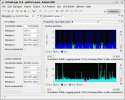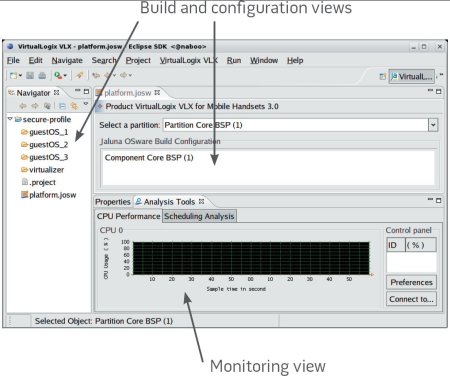Graphical tools aims to ease embedded virtualization
Apr 2, 2007 — by LinuxDevices Staff — from the LinuxDevices Archive — views VirtualLogix has introduced a graphical configuration, tuning, and development toolsuite for its platform virtualization products. “VLX Developer” helps embedded system designers configure, build, and optimize virtualized platforms so that multiple operating systems and associated… application stacks can optimally share a single hardware platform, according to the company.
VirtualLogix has introduced a graphical configuration, tuning, and development toolsuite for its platform virtualization products. “VLX Developer” helps embedded system designers configure, build, and optimize virtualized platforms so that multiple operating systems and associated… application stacks can optimally share a single hardware platform, according to the company.
VLX Developer works as an add-on to VirtualLogix's flagship “VLX” virtualization products, which currently include:
- VLX-DM (digital multimedia) for DSP-based digital media processors (recently available for Ti “DaVinci” DSPs)
- VLX-NI (network infrastructure) for carrier class telecom equipment (used recently in Radisys's Multicore Dev Kit)
- VLX-MX (mobile experimentation) for mobile phones (recently used in Grundig's U900)
Similar to other virtualization products, such as those offered by VMware Inc., VirtualLogix's VLX products allows a hardware system's physical resources, including RAM, to be divided arbitrarily among multiple guest operating environments.
Previously, VLX products were configured using a commandline-based process. The new VLX Developer graphical tools are easier to use, especially with regard to monitoring and tuning capabilities, VirtualLogix said.

VLX Developer screenshot
(Click to enlarge)
Touted capabilities of VLX Developer include:
- Configuration — allows different guest OSs to be configured with respect to memory partition, root file system, console output, and other parameters
- Build — allows developers to select each component of the system such as an OS, the virtualization engine, or a root file system, then build each component and link the components together, resulting in a system memory image
- Monitor — provides a graphical display of the CPU usage (screenshot) for each OS running on the platform and the time spent for each context switch between OSes (screenshot). This enables users to evaluate, optimize, and qualify system-level performance aspects of their virtualized platforms.
VirtualLogix says it chose to base VLX Developer on the popular, open-source Eclipse tools framework in order to provide “an environment that developers are familiar with,” and to facilitate integration with existing toolsuites. The tool can be used as an Eclipse plug-in, or as a standalone Rich Client Platform (RCP) application.
VirtualLogix (formerly Jaluna) joined the Eclipse Foundation one year ago, and first previewed Eclipse-based tools at last year's Embedded Systems Conference. At this year's ESC, it will debut VLX Developer as a shipping product.
Mark Milligan, VP of marketing, stated, “Our Eclipse-based tools allow embedded software developers to easily integrate virtualization into their development process. This marks the next phase in the adoption of virtualization technology into the mainstream embedded electronics market.”
Eclipse Foundation director Mike Milinkovich added, “VirtualLogix's integration of its Real-Time Virtualization technology with Eclipse broadens the Foundation's ecosystem of software tools for embedded devices.”
Availability
VLX Developer is available now for VirtualLogix VLX products, and is licensed on an annual per-seat basis. VLX Developer is also included in certain Product Development License configurations, with additional seats available separately.
This article was originally published on LinuxDevices.com and has been donated to the open source community by QuinStreet Inc. Please visit LinuxToday.com for up-to-date news and articles about Linux and open source.